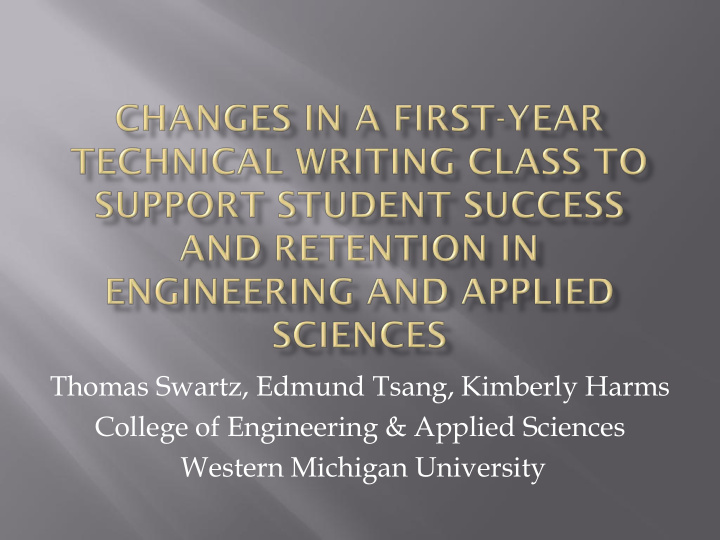



Thomas Swartz, Edmund Tsang, Kimberly Harms College of Engineering & Applied Sciences Western Michigan University
Background of Technical Communication Class Rationale for Change Curricular Changes & Outcomes IME 1020 & STEP Future Work Conclusions
Students who take IME 1020 Service Course Discussions with STEM Faculty STEP (STEM Talent Expansion Program)
Students Need to Better Understand Their Career Choices Recruitment and Retention Improvement Needed Instill Importance of Lifelong Learning (ABET) Industry Demand for Communication Skills
Focus on Career Development Research Paper Lifelong Learning Activity Reports
Career Focus: + 90% participation in one activity 80% in two or more activities Research Paper: + 90% follow the writing process 90% achieve C or better on paper Lifelong Learning: +/- (Still a Struggle) 90% participate in one or more activity 70% participate in four or more activities
STEP Learning Communities (Anchor Class) -- Place ~24 students in the same 3-to-5 classes together Early Intervention -- IME 1020 instructors leverage Residence Life staff to intervene when students missed consecutive classes Academic Etiquette -- Part of Fall Welcome activities, focus on communication strategies for success (verbal/non-verbal, e-mail/phone)
CSDRE 1 WMU Retention 2005 2006 2007 2008 2009 Baseline 2 (262) (303) (306) (349) (315) 2 nd Year (%) 69 57.4 68.0 70.1 66.3 67.5 66.0 3 rd Year (%) 53 42.3 54.3 52.8 52.0 52.1 4 th Year (%) 48.8 5 NA 32.7 44.5 43.3 5 th Year (%) 44.6 4 45.0 7 NA 32.8 6 th Year (%) 40.7 3 41.6 6 32.3 1 For all institutions, 2005-06 5 48.8% returned to CEAS in Year 4 + 2 Averaged 2000-2004 2 graduated with CEAS degrees 6 14.9% continued in 6 th Year + 26.7% 3 37.4% graduated in a STEM field in 6 years + 3.3% continued in 7 th year graduated with CEAS degrees 4 35.1% continued in 5 th year + 9.5% 7 32.4% continued in Year 5 + 12.6% graduated with CEAS degrees graduates with CEAS degrees
Early Intervention: -- (Needs better follow-up) -- Student Affairs & CEAS have different definition of success Academic Etiquette (2010): -- 69.6% SA/A “session was interesting” -- 74.1% SA/A “learned some helpful tips about communicating with professors” -- 78.5% SA/A “will communicate more often with professors and others because of what I learned” -- 56.0% e-mailed instructor prior to first day of class of which 86% used proper e-mail communication (compare with 38.4% e-mailed and 72% used proper e-mail communication in 2009)
Next STEP Career Awareness Integration Across the four years Career Preparation: Emphasize Co-op and Internships Early Intervention: Continue but modify the follow-up procedures
Course Changes are Successful Research Writing is surprisingly so Students better see a need for communication skills Lifelong Learning is worth pursuing but a difficult sell to students
Partial support was provided by the National Science Foundation STEM Talent Expansion Program (STEP) under grants #0336581 and 0969287.
Recommend
More recommend